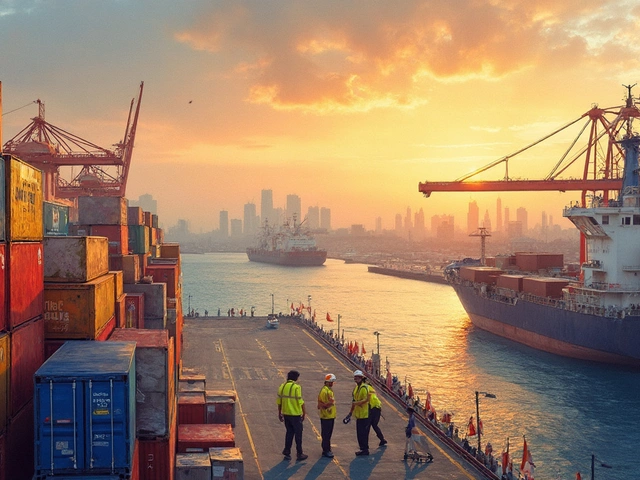If you've got a creative streak—or even just a passion for vintage finds—and you're sitting in India wondering if Etsy is open to you, the short answer is yes. Etsy lets sellers from India open up shop, list handmade goods, art, vintage items, and even craft supplies for a global audience. Sounds pretty cool, right?
But before you head down the rabbit hole of logo design or picking the perfect shop name, there are some practical steps you need to nail down. It’s not just about taking nice photos or writing catchy descriptions. You’ll need to get your paperwork lined up, figure out international payments, and prep for actually shipping orders overseas. The bar isn’t insanely high, but getting things right up front will save you stress and keep your side hustle looking pro from day one.
It’s not a copy-paste job from the US or Europe. Indian sellers have a few extra hoops to jump through, mostly related to payments and shipping. But a lot of folks are already doing it, and some are making solid side income—or even full-time cash—just by selling what they love. Want to join them? Stick around for some real talk and hands-on tips that actually work.
- Starting as an Indian Seller on Etsy
- Payments, Taxes, and Paperwork
- Shipping Orders and Managing Deliveries
- Common Mistakes and How to Avoid Them
- Real Tips for Sustainable Etsy Success
Starting as an Indian Seller on Etsy
If you’re in India and dying to try out the Etsy India scene, you’ll want to know what actually works. Yes, your India-based shop can go global. Tons of folks are doing this, selling everything from block-printed notebooks to quirky brass cutlery. But it’s not quite a walk in the (Lodhi) park.
First up—setting up an account is simple, but doing it right is key. Here’s what you need:
- PAN card (your business or personal one works—just needs to be valid)
- GSTIN if you’re serious about scaling up (if you ship overseas and cross about Rs. 20 lakhs in sales yearly, GST is not optional)
- Bank account that accepts international payouts (most Indian banks today can do this—a standard current or savings account is fine)
- Indian phone number—for verification and alerts
- Clear photos of your products and your logo ready to upload
Once your Etsy shop is up, fill out your profile and shop policies honestly. Global buyers like transparency. Set your shop currency to USD because that’s what Etsy pays you in, and it also attracts American buyers, who form the largest chunk of the Etsy market. Here's a fun stat: over 60% of Etsy’s buyers come from the US according to Etsy’s latest annual report.
You’ll need to choose what you want to sell—handmade goods, vintage (which Etsy defines as anything over 20 years old), or craft supplies. Make sure you pick a niche you can actually ship (for example, no live plants or prohibited stuff).
Etsy India Partnership Lead Priya Khanna says, “Indian sellers bring color, heritage, and story to Etsy’s global platform. We’re seeing more shops traffic every year, especially for textiles, decor, and jewelry.”
Here’s a quick table summarizing what you need to get started as an Etsy seller from India:
| Requirement | Details |
|---|---|
| PAN Card | Mandatory for registration and payouts |
| GSTIN | Strongly advised for export compliance |
| Bank Account | Savings or current, must support international payments |
| Product Photos | High-quality, clear images needed |
Keep all your info handy when signing up. The process takes about 30 minutes if you’ve got your documents and bank details ready. And remember, your shop name should be unique—Etsy doesn’t allow duplicates, so have a few backup ideas in mind.
Payments, Taxes, and Paperwork
Here’s where things get a bit real for anyone setting up shop on Etsy from India. Once you’ve listed a killer product, you want to make sure you actually get paid, right? Etsy is set up to pay Indian sellers, but they do things differently compared to selling locally.
First, you’ll need a registered PayPal business account or a bank account that accepts international payments. Etsy’s Direct Checkout (also called Etsy Payments) isn’t available for Indian sellers, so the main route is PayPal. If you don’t have a PayPal business account, sign up using your PAN number and link your Indian bank account for withdrawals.
- Your Etsy shop should match your PAN and GST details for smooth payments.
- PayPal charges fees (usually around 4.4% plus a fixed conversion rate) whenever you receive payments.
- Funds typically hit your PayPal account within 2-3 business days after a sale. Transferring from PayPal to your bank usually takes another 1-2 days.
Now, let’s talk about legal stuff. Etsy India sellers are technically exporting each time they ship a product abroad, so the government needs some paperwork. You’ll need a GST registration if your sales cross Rs 20 lakhs per year—even if you’re just doing this part-time. For exports, you should get an IEC (Importer Exporter Code) from DGFT; it’s not a massive process, just online signup with your business details and a few documents.
- Declare your products properly while shipping—use forms like commercial invoices and fill out correct HS codes (customs classification).
- Every export should have a GST invoice (don’t worry, plenty of exported items are zero-rated, so you may not actually owe GST, but documentation is a must).
Here’s a quick look at fees and taxes you might deal with:
| Payment Method | Fee (Approx.) |
|---|---|
| PayPal transaction fee | 4.4% per sale + ₹ fixed conversion |
| Etsy listing fee | $0.20 per item (renewed every 4 months) |
| Etsy transaction fee | 6.5% per sale |
| Bank withdrawal fee | Up to ₹50 per transaction (varies by bank) |
Don’t overlook currency conversion. Your US dollar sales will get converted to INR; PayPal’s conversion rate is a bit on the lower side than the real market rate. Double-check if it cuts too much into your profit.
If you’re nervous about the paperwork, check with a local CA (Chartered Accountant) or export consultant—lots of folks are already helping small businesses get all this sorted for a few thousand rupees. They’ll keep you out of trouble and let you focus on building your brand, not fighting forms.

Shipping Orders and Managing Deliveries
So, you've got your first order on Etsy as an Indian seller—now what? Shipping stuff internationally might sound scary, but it's mostly about following a proven process. There are a few unique things to know when sending parcels from India. Here’s how it actually works, without the fluff.
First thing: Etsy India sellers don’t have a built-in shipping service like Amazon does for FBA or Flipkart for local deliveries. You pick your own courier or postal service. Popular options for shipping abroad from India include India Post, DHL, FedEx, Blue Dart, and Aramex. India Post is the most budget-friendly and reliable for small sellers, though it’s a bit slower than express options.
- India Post Registered Airmail: Cheapest for lightweight parcels. Average delivery time: 2 to 4 weeks.
- EMS Speed Post: Faster, but pricier. Delivery in 7 to 14 days.
- Private couriers like DHL/FedEx: Super quick (up to 1 week), better tracking, but costs can cut deep into profits—best for high-value or urgent products.
For any international shipment from India, you need to complete a customs declaration form (usually CN22/CN23 for smaller parcels with India Post). Private couriers handle customs for you, but charge a fee. Always declare things honestly—undervaluing a shipment to save buyer duty can get your account flagged by Etsy or hold up the parcel.
Don't skip packaging—international transit can be rough. Bubble wrap, tough cartons, and waterproof packing go a long way. Etsy buyers love unboxing, but nothing kills that mood faster than a smashed item or one soaked by rain. Write the recipient's address clearly and double-check for errors. Sound simple, but you'd be surprised how many packages bounce back due to a number missing in a postal code.
Tracking is a must if you want to build trust. Even India Post gives basic tracking for registered airmail, though updates aren’t lightning fast. Private couriers offer door-to-door scans but make sure to send your tracking number to the buyer inside Etsy’s system—this can help when there are delivery disputes or delays.
If you’ve never shipped abroad, the first parcel feels like a leap. But pretty soon, it’s just another part of the process. Here’s how the costs and delivery windows generally stack up:
| Courier | Estimated Delivery Time | Price (250g small parcel) | Tracking |
|---|---|---|---|
| India Post Registered Airmail | 2–4 weeks | ₹350–₹800 | Basic |
| EMS Speed Post | 7–14 days | ₹800–₹1200 | Detailed |
| DHL Express | 3–7 days | ₹1500–₹2500 | Full |
| FedEx | 5–10 days | ₹1400–₹2200 | Full |
Most buyers on Etsy expect to pay for international shipping, especially for quality handmade stuff, but high costs can kill your edge—try to price shipping honestly, or bake some of it into your product price and offer ‘free shipping.’
Keep a close eye on package delivery times and always follow up with buyers. Bad reviews from late or lost deliveries hurt sales fast. If a package is stuck in customs, offer help to your buyer—guiding them through any paperwork or payments they might need to handle.
No matter what, save your receipts and shipping docs until your buyer confirms receipt. If things go south, this paperwork often saves the day in Etsy support cases. Shipping globally isn’t magic, but you get the hang of it after a few tries—and soon, your stuff is landing on doorsteps all over the world.
Common Mistakes and How to Avoid Them
Trying to sell on Etsy from India? There are a few classic slip-ups almost everyone trips over at first. Knowing these before you get started can save a lot of headaches—and wasted money.
- Etsy India sellers often set shipping costs too low. International shipping from India can get expensive, especially after factoring in tracking and insurance. Always check real courier prices for the exact item size and weight. If you charge too little, you’re eating into your own profits every time someone outside India hits “buy.”
- Not registering for an Import Export Code (IEC) is another biggie. Etsy payouts for Indian sellers only work if you have this code, plus it’s needed for customs clearance. Skipping this step will cut you out of receiving international payments.
- Some sellers ignore listing requirements. Etsy is strict about what counts as “handmade” or “vintage.” Uploading mass-produced or resold new items risks a shop ban. Always read Etsy’s policy docs before publishing tins of turmeric or bulk jewelry.
- Poor packaging is a killer. Many first-timers wrap things in newspaper or polybags, thinking it’ll survive an international trip. It rarely does. Use bubble wrap, sturdy boxes, and water-resistant tape—your positive reviews depend on it.
- Missing out on tax paperwork hits hard at tax time. You need to collect GST on eligible items and fill out the Letter of Undertaking (LUT) forms for exports. Skip this, and you might end up double-taxed or fined.
Here’s a quick table with data from actual sellers in 2024 on common mistakes and their impact:
| Mistake | Impact | How to Avoid |
|---|---|---|
| Underestimating shipping costs | Loss of ₹300–₹1500 per parcel | Use India Post calculator or courier apps for real quotes |
| Missing IEC registration | No payouts, shipment delays | Apply online via DGFT before opening shop |
| Poor packaging | Damaged orders, bad reviews, refunds | Invest in quality packing supplies and test packaging |
| Not filing GST/LUT | Double tax, fines | Register for GST and file LUT every financial year |
| Violation of Etsy policies | Shop suspension or permanent ban | Stick to Etsy’s guidelines; no mass-produced or fake vintage |
Nobody gets everything perfect the first time. But if you double-check these five points and keep learning from other sellers’ experiences, you’ll be ahead of most of your competition. Your shop’s reputation—and your earnings—will thank you for it.

Real Tips for Sustainable Etsy Success
Staying in the Etsy game isn’t about luck or hoping someone stumbles onto your shop. Indian sellers have a lot to deal with: currency conversion, international shipping, and even just figuring out how to describe their products to a western audience. If you want your shop to last and actually make money, here’s how you keep things running smart.
- Etsy India sellers should always double-check their product pricing. Shipping from India is pricier and slower than local U.S. or European sellers. Use tools like the USPS shipping calculator or India Post’s rates to set prices that don’t leave you in the red.
- Listing photos matter way more than you think. Use a plain background, natural light, and at least five photos per item. If you can, invest in a basic lightbox—you’ll get sharper images for under ₹1,000. Etsy surveys show that 90% of buyers say product images are the main purchase driver.
- Make friends with your local post office staff. Small town or big city, they see a lot of confused Etsy sellers. Ask for help about customs forms—get it wrong, and your package could get stuck for weeks.
- Tweak and update your listings every month. Etsy’s search algorithm likes active shops. Changing keywords or adding new products resets the clock and can give you a mini boost in the rankings.
- Be honest in your descriptions, especially about shipping times. Indian shipments take longer—buyers in the US and UK expect quick delivery. Tell them upfront, and you’ll get fewer complaints.
Here’s a quick look at what a real Indian Etsy seller can expect, on average:
| Item | Average Cost (2024) | Notes |
|---|---|---|
| Etsy Listing Fee | $0.20/listing | Flat fee, auto-renews every four months |
| Shipping (to US) | ₹550–1,200 | Depends on size/weight |
| Etsy Commission | 6.5% | On every sale, including shipping |
| Currency Conversion Fee | 2.5% | Etsy applies this on payments transferred to your account |
If you nail your branding, stay active, and keep learning, you can do well—even with tough competition. Networking with other Indian sellers through Facebook groups or WhatsApp chats brings real, local advice. Even Max, my dog, would agree: don’t just follow the herd; keep adapting and you’ll leave the pack behind.


